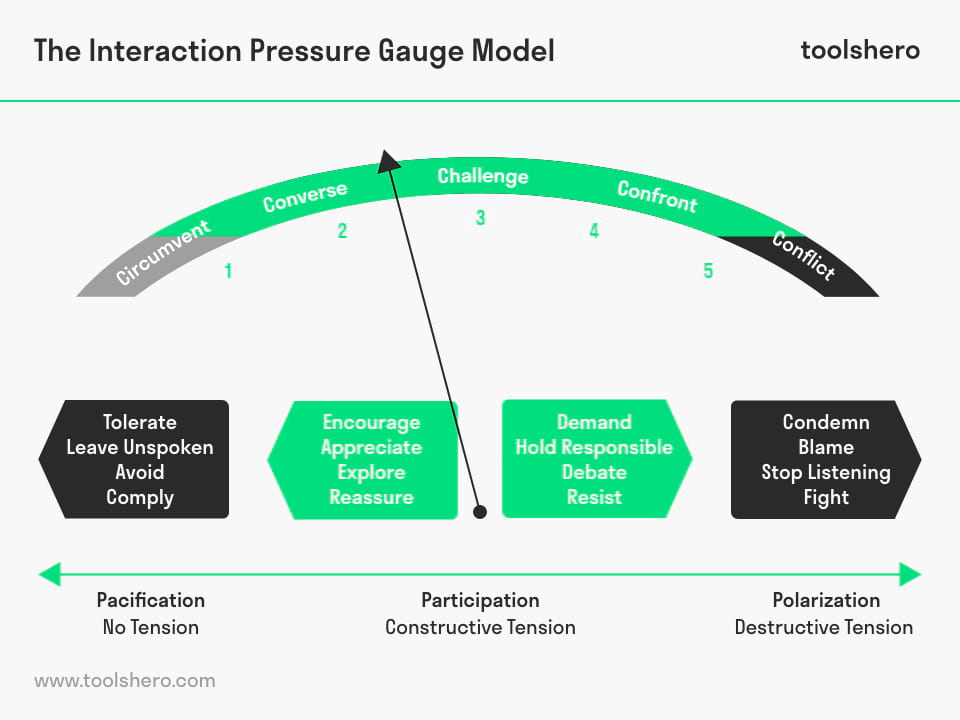Interaction Pressure Gauge

How much pressure should I exert when talking to people?
Key Definitions
Interaction is the process of two or more people communicating with each other, most often by means of talking. For the majority of managers, interacting by means of speech is their primary method of getting things done – their work consists largely of talking.
When interacting, managers need to determine which topics to discuss and what tone of voice to employ in order to achieve their objectives. They can intentionally increase pressure by pushing the other person, or decrease pressure by putting the other at ease.
Conceptual Model
Instead of letting an interaction unfold haphazardly, the Interaction Pressure Gauge indicates that there are three different levels of effective interaction pressure that managers can use, depending on their objective, as well as the person and situation they are dealing with.
Each of these pressure levels produces a constructive tension, drawing the other person into participating in a meaningful dialogue. At the same time, the model points out that managers need to stay away from the opposite extremes of no pressure / tension (pacification) and destructive pressure / tension (polarization).
Key Elements
There are five generic types of interaction, running from low to high levels of pressure:
- Circumvent. Where managers decide not to bring up an issue, but rather to sweep it under the rug and engage in irrelevant small talk instead, we speak of circumvention. Such avoidance behavior can be because managers feel uncomfortable bringing up the topic (fear of awkwardness), or feel unsafe (fear of repercussions) if there is a danger that the other will react negatively. Typical circumventive interaction is full of polite platitudes and empty assurances that ‘everything is fine’.
- Converse. Where managers do bring up an issue, but the tone of voice is an appreciative invitation to explore the topic together, we speak of conversation. This is a type of dialogue whereby the constructive tension is created by encouraging the other to bring in new ideas and / or different perspectives. Key to an effective conversation is recognizing the other as partner in the exchange, whereby active listening and building on the other’s arguments are essential.
- Challenge. Where managers bring up an issue and critically emphasize the difference between their perspective and the other’s, asking the other to close the gap, we speak of challenging. The constructive tension can be based on a gap in beliefs (‘our views differ, you should change your mind’) or a gap in behavior (‘I expect different conduct, you should change your actions’). Such challenging interaction can be more one-directional (‘I think you should step up’) or more like a two-directional debate (‘we seem to disagree’).
- Confront. Where managers bring up an issue and express that certain behaviors or results are not acceptable, we speak of confrontation. While the challenging manager will set the bar, but will still be open to debate it, the confronting manager will make the norm explicit and demand compliance. While this interaction is highly pressured (‘this is how I want you to behave’) it still qualifies as a constructive tension, because clarifying expectations and setting behavioral rules allows the other person to align or leave.
- Conflict. Where managers bring up an issue, but the other person reacts by defending his / her position and trying to win the argument, we speak of conflict. The interaction is no longer a positive-sum activity, intended to achieve a joint objective, but a zero-sum game, in which only one side can win. Such a fight, which can quickly become emotional, can be due to the other person’s unwillingness to listen or deal with disagreement, but it can also be due to the manager’s destructive intention to blame or condemn..
Key Insights
- Not one best way of interacting. Between the two extremes of circumvent and conflict (actually our human default flight and fight behaviors) there are different ways of effectively interacting, despite the many training programs that push one best way.
- People tend to have a preference. In general people feel more comfortable with one particular interaction type, thereby often not using the others enough. This preference can be due to habit/skill (practice makes perfect), but can also be due to fear (fear of conflict pushes people to the left, fear to look weak pushes people to the right).
- Encouraging vs. Demanding Leadership. A preferred level of pressure even translates into people’s dominant leadership style. Encouraging leaders hang out on the left (with circumvent as their pitfall), while demanding leaders stay to the right (with conflict as pitfall).
- You can steer how you interact. It pays to be more intentional when setting an interaction pressure level. Successful managers consciously select a certain level and are able to throttle the pressure up or down during the interaction depending on how things unfold.
- Interact situation and person-specific. Effective interaction requires that managers are not lead by their preferred approach (‘it needs to feel authentic’) but by what is needed in the specific situation and by the person with whom they are interacting (‘it needs to fit’).
How to cite this article:
Meyer, R. (2019). Interaction Pressure Gauge. Retrieved [insert date] from toolshero: https://www.toolshero.com/management/interaction-pressure-gauge/
Add a link to this page on your website:
<a href=”https://www.toolshero.com/management/interaction-pressure-gauge/”>toolshero: Interaction Pressure Gauge</a>













